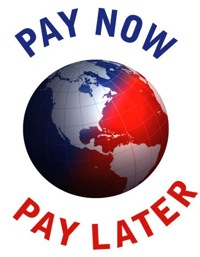
Climate Change we either Pay Now, or Pay Later
Last year, ASP released a series of 50 reports which analyze and project possible economic losses—or in some cases, gains—on a state-by-state basis as a result of unmitigated climate change.
These report – “Pay Now, Pay Later” – draws attention to the costs of inaction for each state if we fail to reduce greenhouse gas emissions.
With Hurricane Sandy bearing down on the East Coast, yesterday ASP’s Andrew Holland noted:
Hurricane Sandy, fresh off its pummeling of Cuba and Jamaica (where it killed 29 people) has turned towards the American East Coast. Well – that’s not quite accurate: it is following a track that would normally drive it out to sea, but instead it is predicted to take a hard left turn after it passes Cape Hatteras and dive directly into the East Coast, between Norfolk, VA and Providence, RI, sometime Monday or Tuesday.
Andrew Freedman over at Climate Central is doing great work showing where the storm is, what it is doing, and what forces are driving it. The kicker of his post, “Historic ‘Frankenstorm’ Aimed At Mid-Atlantic, Northeast” is that there may be a link between ice melt in the Arctic (recall, this year saw a record low of ice) and weather patterns like this. Read the whole post for way more detail and technical understanding of these weather patterns than I could give.
Next week, ASP is releasing its new “Climate Security Report” with an event on Thursday morning. You can find more details here
Gov. Christine Todd Whitman (R-NJ), a former Administrator of the Environmental Protection Agency (EPA) and who serves on the Board of Directors at the American Security Project (ASP), noted on Pay Now, Pay Later:
“Too often the debate about climate breaks down over cost, with many Americans rightfully concerned about what limiting pollution would do to our economy. But what this series of reports shows is that there is a cost on the other side of the ledger, too. There will be costs to our economic security from climate change—and significant ones at that—if we do nothing but continue business as usual.”
Pay Now Pay Later show the costly, negative effects on our communities, our industries, and our jobs. The cost of inaction outweighs the cost of transforming our old energy economy into a green one. According to the Congressional Budget Office, a prominent cap-and-trade proposal would have cost $22 billion a year by 2020—a total of roughly $175 per US household. A small amount compared to the costs inaction will likely inflict. Moreover, one study finds investments in renewable energy—which requires less spending on machinery and imports—creates 3.5 more jobs per dollar spent than spending on the old energy economy (Source).
As we brace for the effects of Sandy, it is worth reading (again) the costs of what we will face, unless we begin to solve the real problem of climate change.






[…] Climate Change we either Pay Now, or Pay Later […]
[…] 5. Climate Change we either Pay Now, or Pay Later […]
[…] 5. Climate Change we either Pay Now, or Pay Later […]